Although I am surrounded by all types of
wildlife, including robins, blue tits, wagtails, tree creepers,
nuthatches, crows, magpies, sparrow hawks, buzzards, goshawks, rabbits, grey squirrels,
weasels, stoats, hedgehogs, woodpeckers, pigeons,
deer, pheasants, heron, foxes and sparrows, amongst many other small birds, I
never shoot any wildlife. I enjoy shooting paper and metal targets
whereby the spent lead is collected in a container within the target.
More on wildlife with photos and videos in my
Wildlife Pets article.
I moved to the countryside 20 years ago and although I have fields, it
is my garden that becomes the battleground in my never ending war
against rats and squirrels. Nature takes care of the fields as all
wildlife is in balance; the buzzards, sparrow hawks, goshawks, owls,
weasels, mink, stoats and foxes take care of the
vermin like mice, rats, squirrels and help keep the rabbit population at
bay. In the garden, I keep the feeding of wildlife in balance so there is no need for me to shoot anything,
including
the rats,
squirrels and rabbits.
Rats
The rats always appear in October, if there is a food source, and if you
are not careful they will breed and remain forever.
Many people will use a .22 PCP air rifle or a .22 springer air rifle to exterminate rats but rat
infestation is an uphill battle. They very soon get the picture and
revert to night activities whilst hiding down their rat holes during the
day. They breed (like rats) depending on their food source. So to
exterminate them, you remove all of the food source such as peanuts and
seed for the small birds and after a few days, you lace the rat holes
with blocks of poison, making sure that you throw the blocks far down
the holes to ensure other wildlife cannot reach them. Poison blocks can
be purchased from equine food stores like Harbro but only domestic strength; if you want to
purchase the stronger rat poison, you will have to take a training
course and become certified to use it. Typically, farmers undertake such
courses as they store large food stocks for their animals, which
encourage rats.
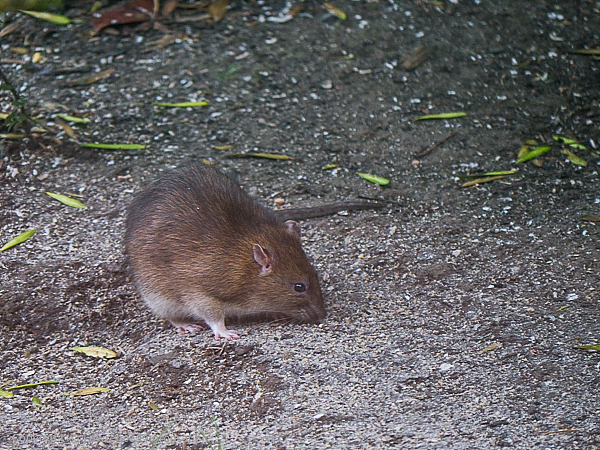
You can shoot rats which is challenging but as sure as night follows
day, they will outbreed your efforts as long as there is a food source.
Even bird feeders are a problem as the blue tits and finches usually
pick at the nuts and seed which causes bits to fall on the ground -
great for ground feeding birds but also for the rats. Rats love to climb
trees and bushes and can easily jump to a nearby bird feeder on a stand
in the garden. Once you have eradicated all the rats the bird feeders
can go back out, but during winter when food is scarce, the rat wars can begin again.
Squirrels
The tree rat known as the squirrel is adorable and they stand on the
patio outside and look into the house with those
pleading eyes for you to throw them some nuts or even a biscuit. Squirrels are
another pest if there is food about, and they love to chew on garden
wooden furniture, so if you are infested by squirrels, purchase metal
furniture for the garden.
You don't have to shoot squirrels, just make sure that
the bird feeders are squirrel proof and they will gradually head off to find
a more lucrative food source. If you feed a couple of squirrels by
throwing out nuts, all you do is encourage them to breed up to the food
source and soon there are lots sitting outside on your patio, along with
the rats, waiting to be fed. More on squirrels in the bird feeder
section below.
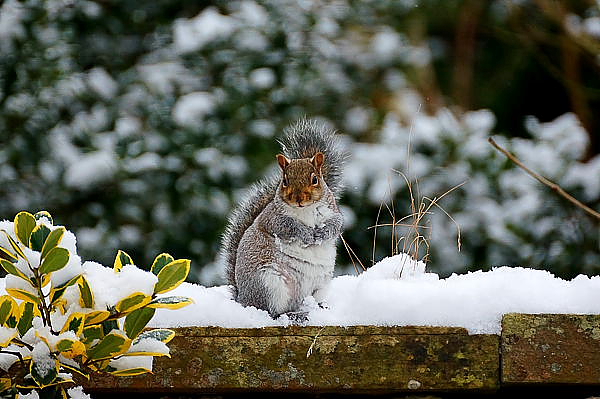
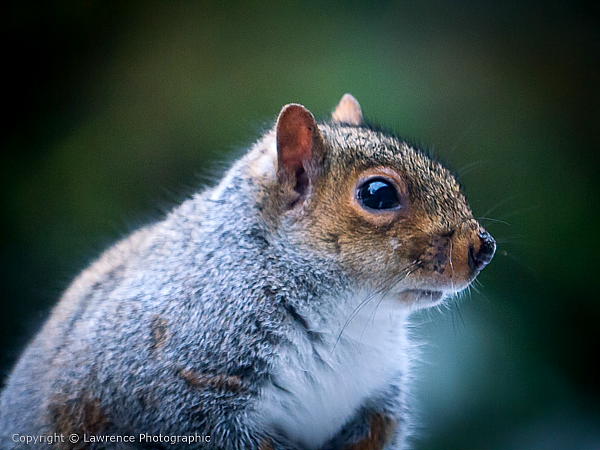
Sitting on top of a gnawed wooden chair - those pleading eyes -
It is a huge mistake to feed squirrels because they breed like rats if there is a constant food source

A young squirrel inside my woodpecker friendly, squirrel proof bird
feeder -
I caught this little chap a couple of times by quickly popping a plastic
bag up and around the feeder. Trapped inside the feeder he squealed like
a stuck rat but eventually I let him free and away he went at a fast
rate of knots, unharmed. I figured he would never come back - not a bit
of it, he was back the next day and inside the feeder again. After
catching him again, I gave up and let him do his thing. Thankfully, he
outgrew the feeder as he fattened up on the nuts.
Bird Feeders & Stand
Bird feeders only require to go out in very bad wet or cold weather,
especially during the winter months because in normal spring and warm
summer weather, insects and bugs are in good supply PROVIDED your garden
has a decent cover of wild flowers, bushes, and especially fir trees
which harbour such creatures. I am fortunate that I have a garden pond
which draws to it all manner of wildlife and even mice who live
underneath it in the sand ballast. A barn owl spends many a night on a
nearby tree, hunting mice at my pond which is lit up by the outside
night lights.
I go through about 8 bird feeders a year, and I have tried every type of bird
feeder you have ever come across in the shops and online. The ones that
have no secondary outer strong wired (multiple squares) frame to deter squirrels, last about 5 days until a
determined squirrel gnaws at the thin wiring and strips out a
small section at the bottom of the feeder and let loose all the nuts
which drop to the ground. The solid single metal shell type with cut
holes never gets damaged but the squirrels know exactly how to break and extract
the nuts through the holes and you end up filling it every day. A
squirrel's claws are like little needles which they use with great
effect for extracting nuts. As for
plastic feeders, forget it, squirrels love to open them up.
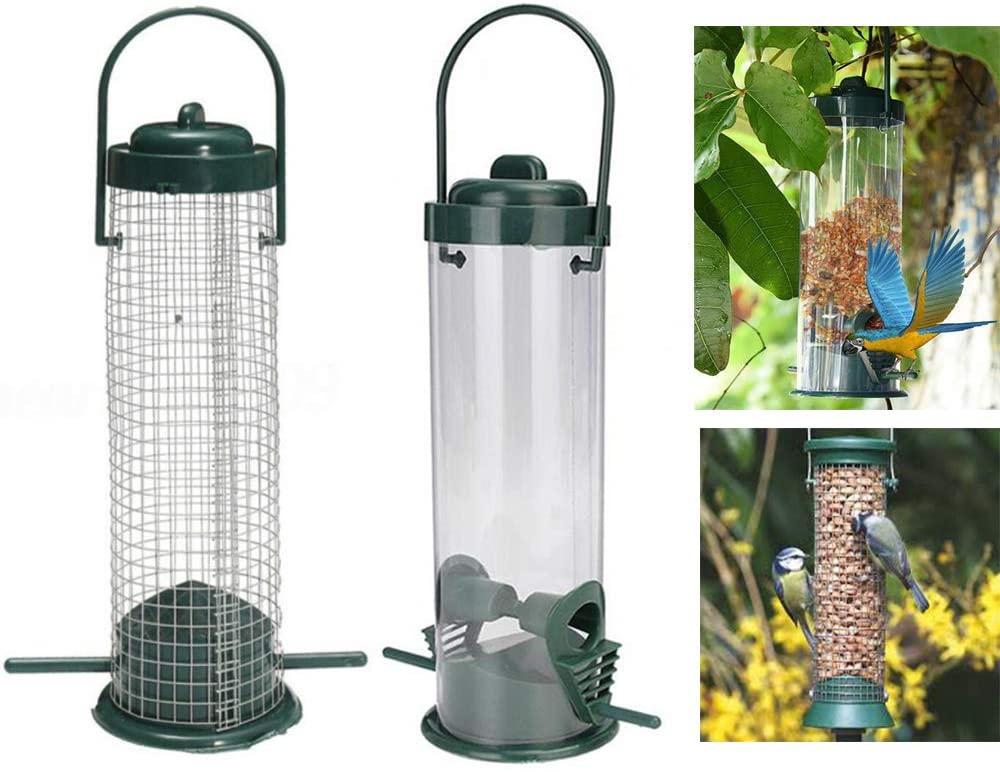
I tried the double skinned bird feeder type and thought I was onto
a winner. These feeders come with
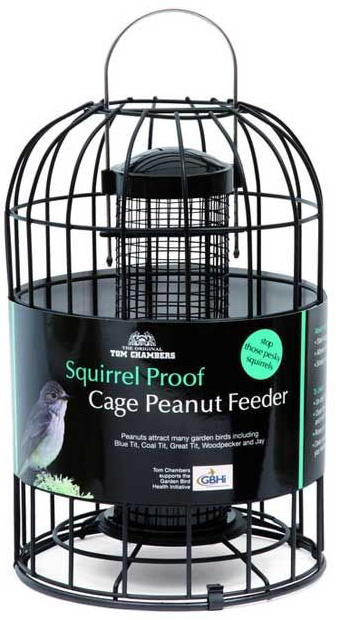 a straight frame of hard wire
squares surrounding a thinner wired inner core round feeder which to all
accounts, seems squirrel proof - wrong. When a newly born squirrel,
finally emerges from
the drey, some 20 feet up a tree, it
follows its mum to the garden and the nut feeders. Old mum is too large
to fit inside between the outer and inner rings of wire mesh but no
problem for the youngster as he is about a third of her size. Okay, that
problem only lasts for a short while because he grows very quickly but he makes a hell of a mess to the
inside core of the feeder in the process and all the squirrels get a
share of the fallen nuts. (see squirrel in feeder above)
a straight frame of hard wire
squares surrounding a thinner wired inner core round feeder which to all
accounts, seems squirrel proof - wrong. When a newly born squirrel,
finally emerges from
the drey, some 20 feet up a tree, it
follows its mum to the garden and the nut feeders. Old mum is too large
to fit inside between the outer and inner rings of wire mesh but no
problem for the youngster as he is about a third of her size. Okay, that
problem only lasts for a short while because he grows very quickly but he makes a hell of a mess to the
inside core of the feeder in the process and all the squirrels get a
share of the fallen nuts. (see squirrel in feeder above)
The final solution is a tricky one because rats and squirrels climb trees and bushes and
rats can easily get inside a double wire skinned feeder, they are also
great jumpers and can easily clear about a foot to a bird feeder. To
make matters worse, rats and squirrels can easily climb up the bird
feeder stand. Then there is the counter problem, if you place the bird
feeder on a metal pole stand, you must plan for the flight path of a
hawk who will use a bird feeder location to hunt small birds. If you use
a double skinned bird feeder of the straight variety, there is usually a
large gap between the inner and outer frame - so you will find that the
most beautiful of birds, the woodpecker will have great difficulty is
getting his head in to reach the inner casing which contains the nuts.
It is important to use a feeder that can accommodate a woodpecker
getting his beak to the nuts but this feeder below lasted only a few weeks
before the squirrels managed to break the porcelain base.
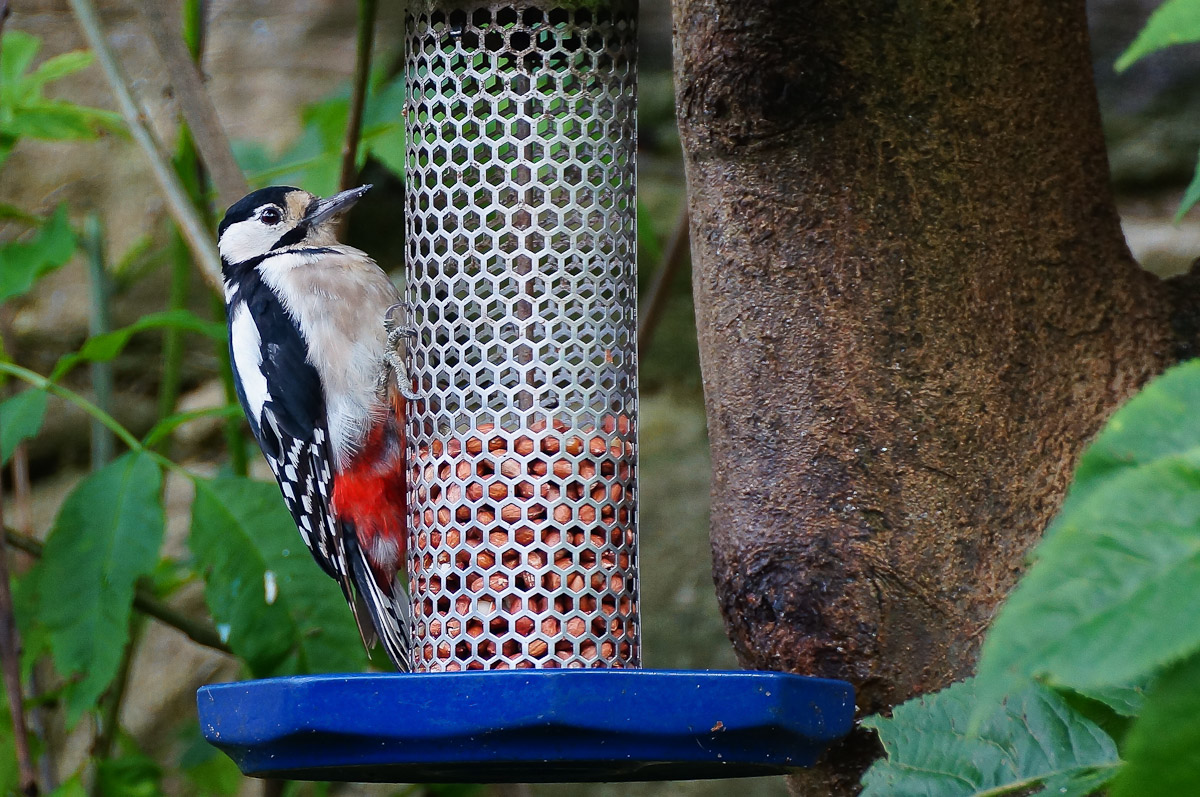
There is no easy answer to feeding little birds without the intrusion of
rats and squirrels.
An earlier effort
- feeders placed further away from the fir tree. This failed because the
squirrels could still get to the feeders but the finches stayed away,
due to their escape flight exposure. The hawk had worked out how to
hunt them as they flew from the feeders. Mum squirrel can still jump from the fir tree -
FINAL SOLUTION
I hung double
skinned bird feeders with nuts and made sure they had a narrower
top and bottom which are angled in so that the woodpecker's head can
gain easy access through the outer frame to the inner nut core
section whilst still having the ability to watch out for hawks and
make any escape.
I put the feeders almost into the fir tree so that the small birds could
enter through the fir tree and make their escape from a hawk by going
back into the fir tree. I had to accept that the squirrels would
continue to destroy my feeders and I will have to replace them when
necessary. In an attempt to reduce squirrel damage to feeders, I hand feed the
squirrels at dawn and at dusk with just enough nuts to fill them up. If
they get too many nuts they will bury them in the garden and encourage
rats.
A 4K video of my garden squirrels which was uploaded (unedited) to
YouTube. It was shot on a dull day with light snow falling and I used a
relatively inexpensive Crosstour CT9900 action camera to make it -
Fat balls can be
placed in double skinned fat ball feeders and seed in double skinned
feeders with inner plastic tubes to hold it. Blue tits love to chuck out
the seed they don't like whilst searching in the feeder for seed they do
like. Ground feeders such as robins, thrushes, blackbirds and some
finches will gobble up the bits that fall out of the feeders.
However, too much seed and/or nuts lying on the ground can encourage the rats back, and once again the feeders
have to be removed, to reduce the food source.
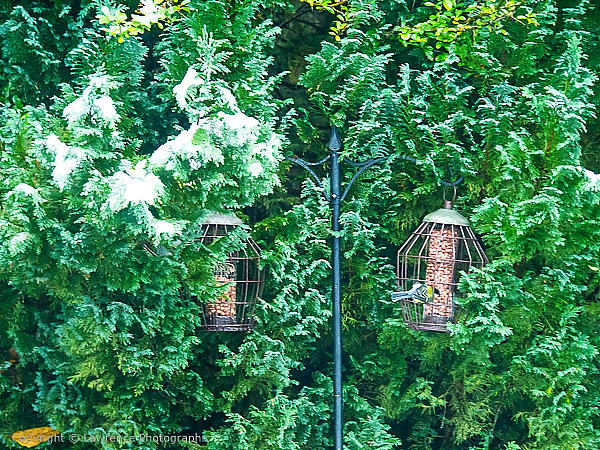
Footnote
Its easy to blast away at rats and
squirrels in the garden with an air rifle and have some fun in the process (if you
enjoy killing them) but if you like the other wildlife all around you,
and especially when they get to know you - why would you want to scare
them away. I cannot hold a squirrel or even a rat to account if there is
food left lying on the ground. Unfortunately, just like the wildlife
balance in the fields, I have to balance the garden and the way I feed
the wildlife there, lest the rat and squirrel wars continue.